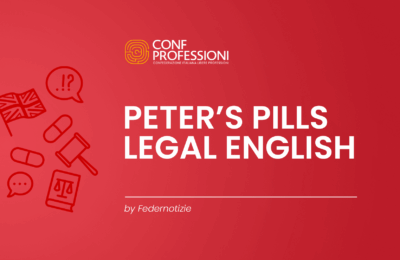Nuovo appuntamento con “Peter’s Pills“, la rubrica online di Legal English by Federnotizie (la rivista online di Federnotai), in collaborazione con Confprofessioni e Beprof. La 34esima video-lezione “Freehold, Leasehold and Commonhold estates” è disponibile sul sito www.federnotizie.it, sui canali social e sul sito di Confprofessioni e sull’app Beprof, scaricabile da App Store e Google Play.

LESSON N. 34: CLICCA SOTTO PER IL VIDEO
Transcript:
Hello!
Technically speaking all land in the UK is ultimately owned by the Crown and the most that anyone else can have is called an estate in the land. “Estate in land” means the rights which a person has to control and use the land. An estate owner is often said to have ownership (proprietà) of the land but legal specialists prefer to use the term “tenure” to express the way people “hold” land.
The three main forms of estate – or forms of tenure – in the UK are: freehold, leasehold and commonhold.
Freehold
- Houses (villa singola con giardino) are generally sold freehold, but newer houses may be leasehold.
- Freehold means that you own the building – or property – and the land it is on.
- You do not have to pay ground rent to anyone.
- You can freely make alterations to your property if you have planning permission (permesso di costruzione rilasciato dal Comune).
Leasehold
- Flats (appartamenti) are generally sold leasehold.
- If you own a leasehold property, you do not own the land it is on and you own neither the shared parts, like the entrance hallway (l’androne) and stairs, nor the structure of the building.
- You must pay ground rent and a service charge to the landlord.
- You have to comply with (rispettare) any restrictions the landlord puts in the lease – e.g. not to have pets or not to run a business (gestire un’attività) from your flat.
- You must have the landlord’s permission to make structural alterations to your property even if you have planning permission.
- The first person who buys a leasehold property signs a lease to use and occupy the flat for a certain number of years, like 99 years. Every time the property is sold, the lease is assigned to the new buyer, so the length reduces. As your lease gets shorter, the value of your flat will decrease.
Commonhold
- Commonhold is a form of ownership – or tenure – for multi-occupancy developments. Each flat, townhouse (villetta a schiera) or house in the complex owns the freehold of the home, and a commonhold or residents’ association owns and manages the common parts of the property.
- There are standardised rules for commonhold.
- Commonhold gives owners more control over the management of their development than leasehold does, but very few commonholds have been created since the system was introduced in 2004.
An interesting statistic: Half of England is owned by less than 1% of its population. About 25,000 landowners – mainly members of the aristocracy and corporations – have control of half of the country.
Thank you very much and see you next time for more Peter’s Pills to improve your Legal English!
Read more here: “Half of England is owned by less than 1% of its population“.

